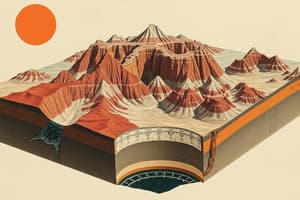Podcast
Questions and Answers
Fold mountains are formed by volcanic activities.
Fold mountains are formed by volcanic activities.
False (B)
Rocky Mountains in North America is an example of fold mountains.
Rocky Mountains in North America is an example of fold mountains.
True (A)
Volcanic mountains are formed through tectonic activity.
Volcanic mountains are formed through tectonic activity.
False (B)
Mount Everest is an example of a volcanic mountain.
Mount Everest is an example of a volcanic mountain.
Fault-block mountains are formed by folding and buckling of the Earth's crust.
Fault-block mountains are formed by folding and buckling of the Earth's crust.
Dome mountains have steep slopes caused by landslides and heavy rainfall.
Dome mountains have steep slopes caused by landslides and heavy rainfall.
Fault-block mountains occur along major breaks in the earth's crust known as fault lines.
Fault-block mountains occur along major breaks in the earth's crust known as fault lines.
Dome mountains are also known as 'fold' structures.
Dome mountains are also known as 'fold' structures.
Volcanic mountains result from large sections of the Earth's crust sliding past each other horizontally.
Volcanic mountains result from large sections of the Earth's crust sliding past each other horizontally.
Examples of fault-block mountains include Death Valley in California and the Great Rift in Africa.
Examples of fault-block mountains include Death Valley in California and the Great Rift in Africa.
Dome mountains usually have sharp peaks and steep sides.
Dome mountains usually have sharp peaks and steep sides.
Active volcanoes play a role in the formation of dome mountains.
Active volcanoes play a role in the formation of dome mountains.
Flashcards are hidden until you start studying
Study Notes
Mountains
Mountains exist throughout the world, their defining characteristic being elevated land above sea level. They can form from various geological processes, including tectonic activity, erosion, glacial actions, weathering, and volcanic activities. Here, we explore four main types of mountain ranges based on their formation mechanisms: fold mountains, volcanic mountains, fault-block mountains, and dome mountains.
Fold Mountains
Fold mountains are formed through the bending, buckling, and shortening of Earth's crust due to collisions between continental plates or oceanic plates. This type of mountain is characterized by its elongated ridges and valleys, which have been created over millions of years as the earth's lithospheric plates move against one another. Some examples of fold mountains include the Rocky Mountains in North America, Himalayas in Asia, and Urals in Russia.
Volcanic Mountains
These mountains come into existence when hot molten rock called magma rises up and solidifies near the Earth's surface following intense volcanic activity. As this process repeats itself, it forms layers upon layers of hardened volcanic ash, forming what we know today as a mountain range like Mount Everest or Mount Kilimanjaro. These mountains often stand out because they are made mostly of rocks formed by such volcanic events, with steep slopes caused by frequent landslides and heavy rainfall.
Fault-Block Mountains
Fault-block mountains occur along major breaks in the earth's crust, known as fault lines, where large sections of the Earth's brittle outer layer slide past each other horizontally. Over time, blocks of the ground rise up while others sink down, creating dramatic changes in landscape. Examples of these mountains include Death Valley in California and the Great Rift not only in Africa but also around the Mediterranean Sea.
Dome Mountains
Also known as 'dome' structures, these mountains result from massive heat deep within the planet causing the rock beneath them to expand and bulge upward like a balloon filled with air. Rather than having sharp peaks, these mountains typically exhibit broad, flat summits and gentle sloping sides. An example is Jebel Akhdar Mountain Range in Oman.
In summary, understanding the different ways mountains are formed sheds light on our history and evolution. From slow-growing fold mountains shaped over millennia to sudden appearances caused by active volcanoes or the movement of tectonic plates, each type reflects particular aspects of how our planet has changed.
Studying That Suits You
Use AI to generate personalized quizzes and flashcards to suit your learning preferences.



